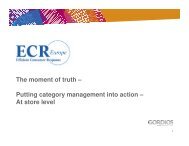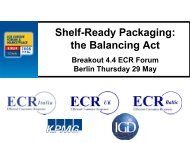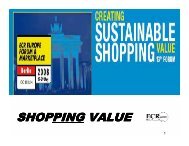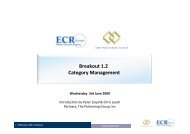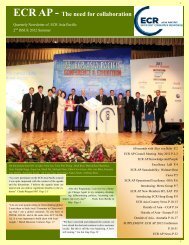You also want an ePaper? Increase the reach of your titles
YUMPU automatically turns print PDFs into web optimized ePapers that Google loves.
The current situation, in which manufacturers typically<br />
use pallets and retailers favour roll cages, is a barrier to<br />
Efficient Replenishment. As cross-docked volume<br />
increases, the need for an integrated tertiary item –<br />
used across the total supply chain – becomes critical.<br />
Suppliers of tertiary items need to develop a tertiary<br />
item which combines the advantages of pallets with<br />
those of role cages to enable effective cross-docking.<br />
The Dolly is one such item but it is only suitable for<br />
those applications using RTI.<br />
Technical developments are required to integrate<br />
pallets and roll cages.<br />
EUL projected savings of 1.2% of retail sales price are<br />
not evenly spread among manufacturers and retailers.<br />
Retailers expect to gain three quarters of the savings,<br />
mainly through more efficient assortment creation and<br />
shelf replenishment. However, retailers’ operational<br />
gains are likely to be manufacturers’ investment needs.<br />
For example, switching to RTI to achieve more efficient<br />
retail shelf operations will require manufacturers to<br />
invest in the production line.<br />
EUL opportunities are not equally spread between<br />
manufacturers and retailers.<br />
Future pricing must incorporate a suitable<br />
compensation mechanism to ensure that such<br />
investment takes place.<br />
A clear vision, leadership and a long-term perspective<br />
are required to ensure that projected <strong>ECR</strong> savings<br />
become a reality.<br />
Efficient Unit Load developments require a processand<br />
category-oriented approach.<br />
In order to make best use of spaces available in the<br />
supply chain and to minimise the overall handling<br />
along the chain, the unit loads design must be very<br />
process-oriented, together with the principal<br />
replenishment flow modules, allowing category-specific<br />
increases in cross docking and break bulk operations<br />
EUL make optimal use of spaces available in the<br />
supply chain and minimise handling.<br />
This Report provides guidelines rather than standards.<br />
It should be used by standards bodies, and by<br />
manufacturers, retailers and service providers, working<br />
together to design and operate Efficient Unit Loads<br />
supply chains. This will “fulfil consumer wishes better,<br />
faster and at less cost.”<br />
Source: A.T. Kearney<br />
Space<br />
Utilisation<br />
Direct<br />
Cross<br />
Space Utilisation<br />
The Efficient Unit Loads Report 7<br />
dock<br />
Break<br />
bulk<br />
Via stock<br />
Manufacturer Cost Impact<br />
0.3%<br />
+<br />
0.9%<br />
Handling<br />
Efficiency<br />
Handling Efficiency<br />
Retailer Cost Impact<br />
Source: A.T. Kearney Survey, Efficient Unit Loads project<br />
Other<br />
Other



